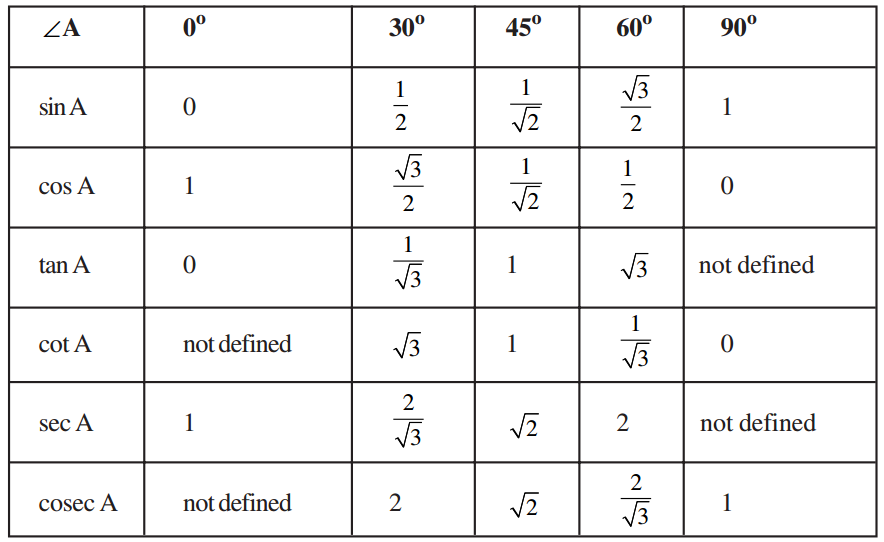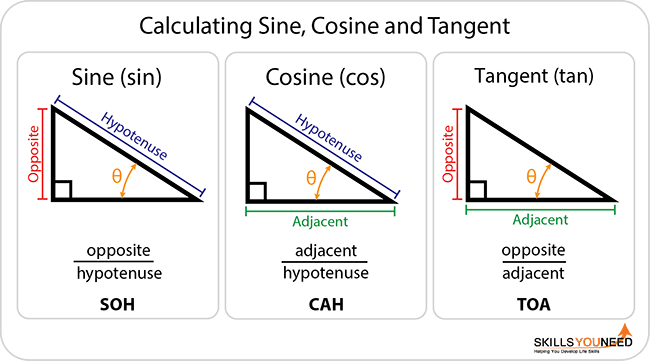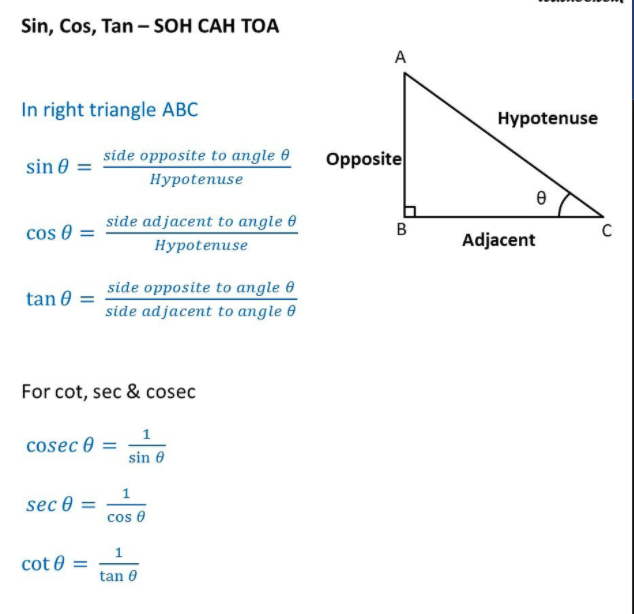The basic trigonometric functions include the following (6 ) functions: sine ( left( sin x right), ) cosine ( left( cos x right), ) tangent ( left( tan x right. Feb 23, 2021 Trig calculator finding sin, cos, tan, cot, sec, csc To find the trigonometric functions of an angle, enter the chosen angle in degrees or radians. Underneath the calculator, six most popular trig functions will appear - three basic ones: sine, cosine and tangent, and their reciprocals: cosecant, secant and cotangent.

- Sine, Cosine, and Tangent Practice Find the value of each trigonometric ratio. Express your answer as a fraction in lowest terms. 1) sin C 20 21 29 C B A 2) sin C 40 30 50 C B A 3) cos C 36 15 39 C B A 4) cos C 8 17 15 C B A 5) tan A 35 12 37 A B C 6) tan X 27 36 45 X Y Z-1.
- Inverse Tangent Calculator There are 2 different ways that you can enter input into our arc tan calculator You can enter input as either a decimal or as the opposite over the adjacent.
The basic trigonometric functions include the following (6) functions: sine (left(sin xright),) cosine (left(cos xright),) tangent (left(tan xright),) cotangent (left(cot xright),) secant (left(sec xright)) and cosecant (left(csc xright).)
All these functions are continuous and differentiable in their domains. Below we make a list of derivatives for these functions.
Derivatives of Basic Trigonometric Functions
We have already derived the derivatives of sine and cosine on the Definition of the Derivative page. They are as follows:
[{{left( {sin x} right)^prime } = cos x,;;}kern-0.3pt{{left( {cos x} right)^prime } = – sin x.}]
Using the quotient rule it is easy to obtain an expression for the derivative of tangent:
[
{{left( {tan x} right)^prime } }={ {left( {frac{{sin x}}{{cos x}}} right)^prime } }
= {frac{{{{left( {sin x} right)}^prime }cos x – sin x{{left( {cos x} right)}^prime }}}{{{{cos }^2}x}} }
= {frac{{cos x cdot cos x – sin x cdot left( { – sin x} right)}}{{{{cos }^2}x}} }
= {frac{{{{cos }^2}x + {{sin }^2}x}}{{{{cos }^2}x}} }
= {frac{1}{{{{cos }^2}x}}.}
]
The derivative of cotangent can be found in the same way. However, this can be also done using the chain rule for differentiating a composite function:
[require{cancel}
{{left( {cot x} right)^prime } = {left( {frac{1}{{tan x}}} right)^prime } }
= { – frac{1}{{{{tan }^2}x}} cdot {left( {tan x} right)^prime } }
= { – frac{1}{{frac{{{{sin }^2}x}}{{{{cos }^2}x}}}} cdot frac{1}{{{{cos }^2}x}} }
= { – frac{cancel{{{cos }^2}x}}{{{{sin }^2}x cdot cancel{{{cos }^2}x}}} }
= { – frac{1}{{{{sin }^2}x}}.}
]
Similarly, we find the derivatives of secant and cosecant:
[
{{left( {sec x} right)^prime } = {left( {frac{1}{{cos x}}} right)^prime } }
= { – frac{1}{{{{cos }^2}x}} cdot {left( {cos x} right)^prime } }
= {frac{{sin x}}{{{{cos }^2}x}} }
= {frac{{sin x}}{{cos x}} cdot frac{1}{{cos x}} }
= {tan xsec x,}
]
[
{{left( {csc x} right)^prime } = {left( {frac{1}{{sin x}}} right)^prime } }
= { – frac{1}{{{{sin }^2}x}} cdot {left( {sin x} right)^prime } }
= {-frac{{cos x}}{{{{sin }^2}x}} }
= {-frac{{cos x}}{{sin x}} cdot frac{1}{{sin x}} }
= {-cot xcsc x.}
]
Table of Derivatives of Trigonometric Functions
The table below summarizes the derivatives of (6) basic trigonometric functions:
In the examples below, find the derivative of the given function.
Solved Problems
Click or tap a problem to see the solution.
Example 2
[y = tan x + frac{1}{3}{tan ^3}x]Example 4
[y = frac{1}{{{{cos }^n}x}}]Example 6
[y = {cos ^2}sin x]Example 8
[y = {sin ^2}sqrt x ]Example 10
[y = {sin ^3}x + {cos ^3}x]Example 11
[y = tan frac{x}{2} – cot frac{x}{2}]Example 12
[y = {x^2}sin x + 2xcos x – 2sin x]Example 14
[y = {sin ^n}xcos nx]Example 15
[y = ln sqrt {{frac{{1 – sin x}}{{1 + sin x}}}}]Example 16
Calculate the derivative of the function [y = left( {2 – {x^2}} right)cos x + 2xsin x] at (x = pi.)Example 17
Calculate the derivative of the function [y = left( {x + 1} right)cos x + left( {x + 2} right)sin x] at (x = 0.)Example 18
[y = {sec ^2}{frac{x}{2}} + {csc ^2}{frac{x}{2}}]Example 19
[{y = {left( {tan x} right)^{cos x}},;;;}kern0pt{text{where};;0 lt x lt frac{pi }{2}.}]Example 20
[y = frac{{{{sin }^2}x}}{{1 + cot x}} + frac{{{{cos }^2}x}}{{1 + tan x}}]Solution.
Using the linear properties of the derivative, the chain rule and the double angle formula, we obtain:
[
{y’left( x right) }={ {left( {cos 2x – 2sin x} right)^prime } }
= {{left( {cos 2x} right)^prime } – {left( {2sin x} right)^prime } }
= {left( { – sin 2x} right) cdot {left( {2x} right)^prime } – 2{left( {sin x} right)^prime } }
= { – 2sin 2x – 2cos x }
= { – 4sin xcos x – 2cos x }
= { – 2cos xleft( {2sin x + 1} right).}
]
Example 2.
[y = tan x + frac{1}{3}{tan ^3}x]Solution.
The derivative of this function is
[
{y’left( x right) }={ {left( {tan x + frac{1}{3}{{tan }^3}x} right)^prime } }
= {{left( {tan x} right)^prime } + {left( {frac{1}{3}{{tan }^3}x} right)^prime } }
= {frac{1}{{{{cos }^2}x}} + frac{1}{3} cdot 3{tan ^2}x cdot {left( {tan x} right)^prime } }
= {frac{1}{{{{cos }^2}x}} + {tan ^2}x cdot frac{1}{{{{cos }^2}x}} }
= {frac{{1 + {{tan }^2}x}}{{{{cos }^2}x}}.}
]
The numerator can be simplified using the trigonometric identity
[
{1 + {tan^2}x = {sec ^2}x }
= {frac{1}{{{{cos }^2}x}}.}
]
Therefore
[
{y’left( x right) }={ frac{{1 + {{tan }^2}x}}{{{{cos }^2}x}} }
= {frac{{frac{1}{{{{cos }^2}x}}}}{{{{cos }^2}x}} }
= {frac{1}{{{{cos }^4}x}} }
= {{sec ^4}x.}
]
Example 3.
[y = cos x – {frac{1}{3}}{cos ^3}x]Solution.
Using the power rule and the chain rule, we get
[{y^prime = left( {cos x – frac{1}{3}{{cos }^3}x} right)^prime }={ left( {cos x} right)^prime – left( {frac{1}{3}{{cos }^3}x} right)^prime }={ – sin x – frac{1}{3} cdot 3{cos ^2}x cdot left( {cos x} right)^prime }={ – sin x – {cos ^2}x cdot left( { – sin x} right) }={ – sin x + {cos ^2}xsin x }={ – sin xleft( {1 – {{cos }^2}x} right) }={ – sin x,{sin ^2}x }={ – {sin ^3}x.}]
Solution.
We find the derivative of this function using the power rule and the chain rule:
[
{y’left( x right) = {left( {frac{1}{{{{cos }^n}x}}} right)^prime } }
= {{left[ {{{left( {cos x} right)}^{ – n}}} right]^prime } }
= { – n{left( {cos x} right)^{ – n – 1}} cdot {left( {cos x} right)^prime } }
= { – n{left( {cos x} right)^{ – n – 1}} cdot left( { -sin x} right) }
= {frac{{nsin x}}{{{{cos }^{n + 1}}x}}.}
]
Here we assume that (cos x ne 0), that is (x ne {largefrac{pi }{2}normalsize} + pi n,) (n in mathbb{Z}.)
Example 5.
[y = {frac{{sin x}}{{1 + cos x}}}]Solution.
By the quotient rule,
[require{cancel}{y^prime = left( {frac{{sin x}}{{1 + cos x}}} right)^prime }={ frac{{cos x left( {1 + cos x} right) – sin x cdot left( { – sin x} right)}}{{{{left( {1 + cos x} right)}^2}}} }={ frac{{cos x + {{cos }^2}x + {{sin }^2}x}}{{{{left( {1 + cos x} right)}^2}}} }={ frac{cancel{1 + cos x}}{{{{left( {1 + cos x} right)}^cancel{2}}}} }={ frac{1}{{1 + cos x}}.}]
Solution.
Applying the power rule and the chain rule, we obtain:
[
{y’left( x right) = {left( {{{cos }^2}sin x} right)^prime } }
= {2cos sin x cdot {left( {cos sin x} right)^prime } }
= {2cos sin x cdot left( { – sinsin x} right) cdot}kern0pt{ {left( {sin x} right)^prime } }
= { – 2cos sin x cdot sin sin x cdot}kern0pt{ cos x.}
]
The last expression can be simplified by the double angle formula:
[
{2cos sin x cdot sin sin x }
= {sin left( {2sin x} right).}
]
Consequently, the derivative is
[{y’left( x right) }={ – sin left( {2sin x} right)cos x.}]
Example 7.
[y = xsin x + cos x]Solution.
Using the product rule, we can write:

[{y^prime = left( {xsin x + cos x} right)^prime }={ left( {xsin x} right)^prime + left( {cos x} right)^prime }={ x^primesin x + xleft( {sin x} right)^prime + left( {cos x} right)^prime }={ 1 cdot sin x + x cdot cos x + left( { – sin x} right) }={ cancel{sin x} + xcos x – cancel{sin x} }={ xcos x.}]
The basic trigonometric functions include the following (6) functions: sine (left(sin xright),) cosine (left(cos xright),) tangent (left(tan xright),) cotangent (left(cot xright),) secant (left(sec xright)) and cosecant (left(csc xright).)
All these functions are continuous and differentiable in their domains. Below we make a list of derivatives for these functions.
Derivatives of Basic Trigonometric Functions
We have already derived the derivatives of sine and cosine on the Definition of the Derivative page. They are as follows:
[{{left( {sin x} right)^prime } = cos x,;;}kern-0.3pt{{left( {cos x} right)^prime } = – sin x.}]
Using the quotient rule it is easy to obtain an expression for the derivative of tangent:
[
{{left( {tan x} right)^prime } }={ {left( {frac{{sin x}}{{cos x}}} right)^prime } }
= {frac{{{{left( {sin x} right)}^prime }cos x – sin x{{left( {cos x} right)}^prime }}}{{{{cos }^2}x}} }
= {frac{{cos x cdot cos x – sin x cdot left( { – sin x} right)}}{{{{cos }^2}x}} }
= {frac{{{{cos }^2}x + {{sin }^2}x}}{{{{cos }^2}x}} }
= {frac{1}{{{{cos }^2}x}}.}
]
The derivative of cotangent can be found in the same way. However, this can be also done using the chain rule for differentiating a composite function:
[require{cancel}
{{left( {cot x} right)^prime } = {left( {frac{1}{{tan x}}} right)^prime } }
= { – frac{1}{{{{tan }^2}x}} cdot {left( {tan x} right)^prime } }
= { – frac{1}{{frac{{{{sin }^2}x}}{{{{cos }^2}x}}}} cdot frac{1}{{{{cos }^2}x}} }
= { – frac{cancel{{{cos }^2}x}}{{{{sin }^2}x cdot cancel{{{cos }^2}x}}} }
= { – frac{1}{{{{sin }^2}x}}.}
]
Similarly, we find the derivatives of secant and cosecant:
[
{{left( {sec x} right)^prime } = {left( {frac{1}{{cos x}}} right)^prime } }
= { – frac{1}{{{{cos }^2}x}} cdot {left( {cos x} right)^prime } }
= {frac{{sin x}}{{{{cos }^2}x}} }
= {frac{{sin x}}{{cos x}} cdot frac{1}{{cos x}} }
= {tan xsec x,}
]
[
{{left( {csc x} right)^prime } = {left( {frac{1}{{sin x}}} right)^prime } }
= { – frac{1}{{{{sin }^2}x}} cdot {left( {sin x} right)^prime } }
= {-frac{{cos x}}{{{{sin }^2}x}} }
= {-frac{{cos x}}{{sin x}} cdot frac{1}{{sin x}} }
= {-cot xcsc x.}
]
Table of Derivatives of Trigonometric Functions
The table below summarizes the derivatives of (6) basic trigonometric functions:
In the examples below, find the derivative of the given function.
Solved Problems
Click or tap a problem to see the solution.
Example 2
[y = tan x + frac{1}{3}{tan ^3}x]Example 4
[y = frac{1}{{{{cos }^n}x}}]Example 6
[y = {cos ^2}sin x]Example 8
[y = {sin ^2}sqrt x ]Example 10
[y = {sin ^3}x + {cos ^3}x]Example 11
[y = tan frac{x}{2} – cot frac{x}{2}]Example 12
[y = {x^2}sin x + 2xcos x – 2sin x]Example 14
[y = {sin ^n}xcos nx]Example 15
[y = ln sqrt {{frac{{1 – sin x}}{{1 + sin x}}}}]Example 16
Calculate the derivative of the function [y = left( {2 – {x^2}} right)cos x + 2xsin x] at (x = pi.)Example 17
Calculate the derivative of the function [y = left( {x + 1} right)cos x + left( {x + 2} right)sin x] at (x = 0.)Example 18
[y = {sec ^2}{frac{x}{2}} + {csc ^2}{frac{x}{2}}]Example 19
[{y = {left( {tan x} right)^{cos x}},;;;}kern0pt{text{where};;0 lt x lt frac{pi }{2}.}]Example 20
[y = frac{{{{sin }^2}x}}{{1 + cot x}} + frac{{{{cos }^2}x}}{{1 + tan x}}]Solution.

Using the linear properties of the derivative, the chain rule and the double angle formula, we obtain:
[
{y’left( x right) }={ {left( {cos 2x – 2sin x} right)^prime } }
= {{left( {cos 2x} right)^prime } – {left( {2sin x} right)^prime } }
= {left( { – sin 2x} right) cdot {left( {2x} right)^prime } – 2{left( {sin x} right)^prime } }
= { – 2sin 2x – 2cos x }
= { – 4sin xcos x – 2cos x }
= { – 2cos xleft( {2sin x + 1} right).}
]
Example 2.
[y = tan x + frac{1}{3}{tan ^3}x]Solution.
The derivative of this function is
[
{y’left( x right) }={ {left( {tan x + frac{1}{3}{{tan }^3}x} right)^prime } }
= {{left( {tan x} right)^prime } + {left( {frac{1}{3}{{tan }^3}x} right)^prime } }
= {frac{1}{{{{cos }^2}x}} + frac{1}{3} cdot 3{tan ^2}x cdot {left( {tan x} right)^prime } }
= {frac{1}{{{{cos }^2}x}} + {tan ^2}x cdot frac{1}{{{{cos }^2}x}} }
= {frac{{1 + {{tan }^2}x}}{{{{cos }^2}x}}.}
]
Sin Cos Tan Examples
The numerator can be simplified using the trigonometric identity
[
{1 + {tan^2}x = {sec ^2}x }
= {frac{1}{{{{cos }^2}x}}.}
]
Therefore
[
{y’left( x right) }={ frac{{1 + {{tan }^2}x}}{{{{cos }^2}x}} }
= {frac{{frac{1}{{{{cos }^2}x}}}}{{{{cos }^2}x}} }
= {frac{1}{{{{cos }^4}x}} }
= {{sec ^4}x.}
]
Example 3.
[y = cos x – {frac{1}{3}}{cos ^3}x]Solution.
Using the power rule and the chain rule, we get
[{y^prime = left( {cos x – frac{1}{3}{{cos }^3}x} right)^prime }={ left( {cos x} right)^prime – left( {frac{1}{3}{{cos }^3}x} right)^prime }={ – sin x – frac{1}{3} cdot 3{cos ^2}x cdot left( {cos x} right)^prime }={ – sin x – {cos ^2}x cdot left( { – sin x} right) }={ – sin x + {cos ^2}xsin x }={ – sin xleft( {1 – {{cos }^2}x} right) }={ – sin x,{sin ^2}x }={ – {sin ^3}x.}]
Solution.
We find the derivative of this function using the power rule and the chain rule:
[
{y’left( x right) = {left( {frac{1}{{{{cos }^n}x}}} right)^prime } }
= {{left[ {{{left( {cos x} right)}^{ – n}}} right]^prime } }
= { – n{left( {cos x} right)^{ – n – 1}} cdot {left( {cos x} right)^prime } }
= { – n{left( {cos x} right)^{ – n – 1}} cdot left( { -sin x} right) }
= {frac{{nsin x}}{{{{cos }^{n + 1}}x}}.}
]
Here we assume that (cos x ne 0), that is (x ne {largefrac{pi }{2}normalsize} + pi n,) (n in mathbb{Z}.)
Example 5.
[y = {frac{{sin x}}{{1 + cos x}}}]Solution.
By the quotient rule,
[require{cancel}{y^prime = left( {frac{{sin x}}{{1 + cos x}}} right)^prime }={ frac{{cos x left( {1 + cos x} right) – sin x cdot left( { – sin x} right)}}{{{{left( {1 + cos x} right)}^2}}} }={ frac{{cos x + {{cos }^2}x + {{sin }^2}x}}{{{{left( {1 + cos x} right)}^2}}} }={ frac{cancel{1 + cos x}}{{{{left( {1 + cos x} right)}^cancel{2}}}} }={ frac{1}{{1 + cos x}}.}]
Solution.
Applying the power rule and the chain rule, we obtain:
[
{y’left( x right) = {left( {{{cos }^2}sin x} right)^prime } }
= {2cos sin x cdot {left( {cos sin x} right)^prime } }
= {2cos sin x cdot left( { – sinsin x} right) cdot}kern0pt{ {left( {sin x} right)^prime } }
= { – 2cos sin x cdot sin sin x cdot}kern0pt{ cos x.}
]

The last expression can be simplified by the double angle formula:
[
{2cos sin x cdot sin sin x }
= {sin left( {2sin x} right).}
]
Consequently, the derivative is
[{y’left( x right) }={ – sin left( {2sin x} right)cos x.}]
Example 7.
[y = xsin x + cos x]Solution.
Using the product rule, we can write:
Sin Cos Tan Calculator
[{y^prime = left( {xsin x + cos x} right)^prime }={ left( {xsin x} right)^prime + left( {cos x} right)^prime }={ x^primesin x + xleft( {sin x} right)^prime + left( {cos x} right)^prime }={ 1 cdot sin x + x cdot cos x + left( { – sin x} right) }={ cancel{sin x} + xcos x – cancel{sin x} }={ xcos x.}]